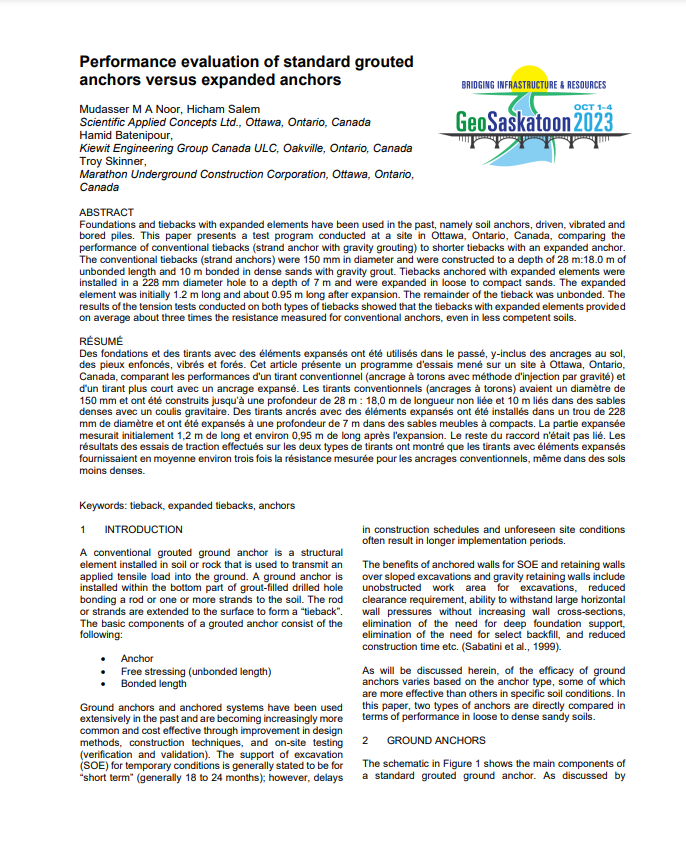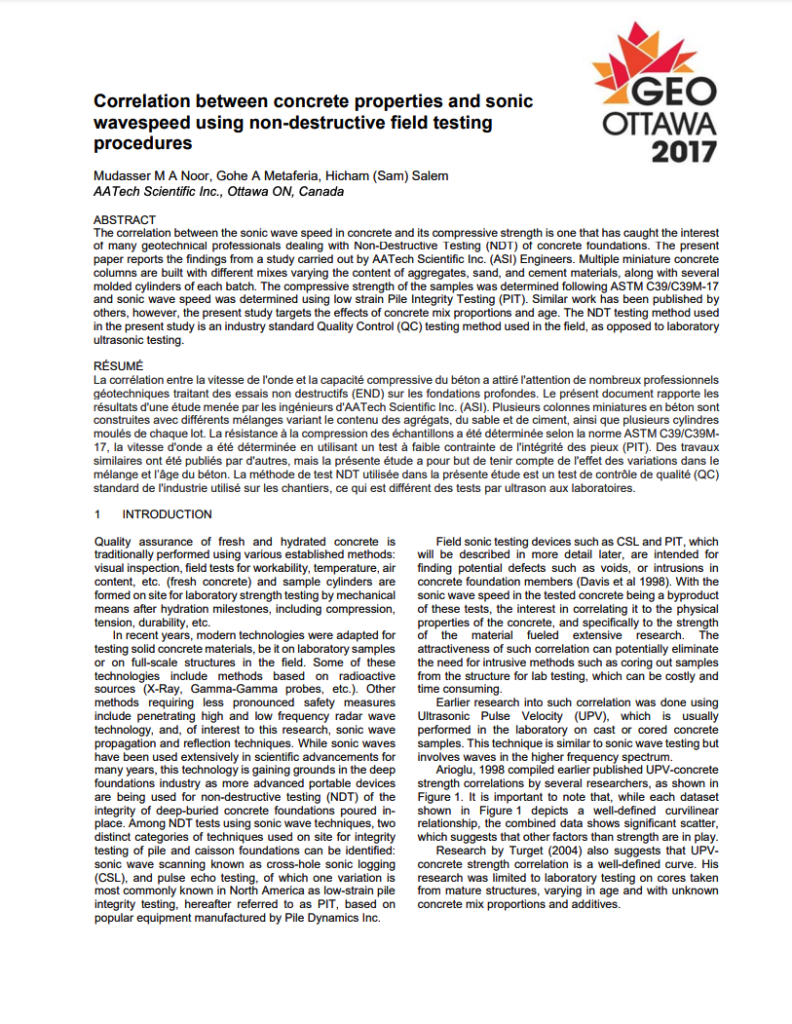Home » Resources
Beyond helping clients realize quality and accuracy with quick and precision testing, Engineers at SACL have been actively involved in Research and Development to uncover insights, discover innovative methods and processes to execute testing and quality control with excellence.
Read through some of the academic resources co-authored by our engineers




-by Bengt Fellenius
Yes, Pulse Echo Testing (PIT) can be used to verify anomalies detected by Crosshole Sonic Logging (CSL) testing. While CSL provides a detailed assessment of the integrity of drilled shafts and other deep foundations by evaluating the sound wave travel times between pairs of access tubes, PIT offers a complementary method by sending a stress wave down the length of the shaft and analyzing the reflected signals. This can help confirm the presence, location, and extent of anomalies such as voids, inclusions, or cracks identified during CSL testing, providing a more comprehensive evaluation of the foundation’s condition. It is important to note, however, that anomalies at the pile toe are difficult to detect using PIT as they can be masked by the toe reflection.
Yes, dynamic testing using the Pile Driving Analyzer (PDA) can be used to test cast in place or continuous flight auger concrete piles (CFA). PDA testing measures the response of a pile to a dynamic load, providing information on pile capacity, integrity, and soil resistance distribution. This requires the PDA Engineer to be highly experienced in setting up and conducting such tests and in selecting and modeling a proper hammer to prevent inducing excessive tensile stresses that can damage the pile.
Yes, bidirectional testing can be performed on bell piles. Bidirectional static load tests (BDSLT) involve installing a load cell within the pile, which applies an upward and downward force simultaneously. This type of testing can accommodate the unique geometry of bell piles, allowing for accurate measurement of their load-bearing capacity and performance under different loading conditions. It is important to note, however, that the pile must have sufficient shaft resistance to counter the end bearing by providing reaction to the bidirectional cell. If this condition is not met, a reaction frame would be needed at the pile head to supplement the shaft resistance.
Yes, bidirectional testing (BDSLT) can replace traditional static load testing (SLT) on many types of piles. BDSLT offers several advantages, including the ability to test the pile’s capacity both in compression and tension using a single test setup. It can provide more detailed information about the pile’s performance and often requires less space and time compared to traditional SLT. However, the applicability may depend on specific project requirements and site conditions. One important condition is the availability of sufficient shaft resistance to provide equal reaction to the cell load in both upward and downward directions.
Yes, PDA testing can help determine the uplift capacity of piles. By analyzing the pile’s response to dynamic loading, PDA testing can estimate the full resistance distribution along the pile which allows the estimation of uplift resistance.
Bidirectional testing (BDSLT) offers several advantages over traditional static loading tests (SLT):
A: Thermal Integrity Profiling (TIP) and Cross-Hole Sonic Logging (CSL) are both methods used to evaluate the integrity of deep foundations, but they operate differently:
The PDCA (Pile Driving Contractors Association) certification for dynamic testing (PDA) is a professional certification that signifies proficiency in conducting and analyzing dynamic load tests using the Pile Driving Analyzer (PDA). This certification ensures that the individual has the necessary skills and knowledge to perform dynamic testing accurately and interpret the results effectively, which is critical for assessing pile capacity and integrity.
The Expander Body (EB) technology is an innovative method used to enhance the load-bearing capacity of piles and foundations. It involves the installation of an expandable device at the base of the pile, which is then inflated to create a larger base diameter, increasing the pile’s bearing capacity and reducing settlement. Yes, SACL has the expertise to design and implement Expander Body technology, leveraging its advanced engineering capabilities and experience in geotechnical solutions.
Dynamic (PDA) or static pile testing (SLT) should be performed ideally before finalizing the foundation design. This is the most effective way to confirm the design parameters and ensuring adequate foundations. Additional testing may be beneficial during the construction phase, after the piles have been installed but before the construction of the superstructure begins. This timing allows for the verification of pile capacity and integrity, ensuring that the foundation will perform as expected under the design loads.
With over three decades at the forefront of the industry, SACL has built an unmatched reputation for innovation and reliability. Serving North America from our offices in Ottawa and Toronto, our expertise has earned the trust of clients across the continent and around the globe.
Whether you’re planning your next major project or have questions about our specialized services, our team is here to provide the support and solutions you need.
Contact us today to learn how we can help drive the success of your most critical projects.

Headquarters
Unit 8,
5330 Canotek Road,
Gloucester,
Ontario K1J 9C3,
Canada.
Phone:
+1-807-700-7225
Email:
info@saclcanada.com
Hours:
Monday to Friday – 09:30 – 17:30 (EST)
Weekends – Closed
© 2024. All rights reserved to Scientific Applied Concepts Ltd. Canada.